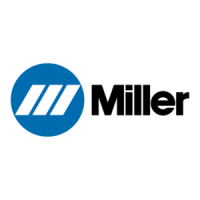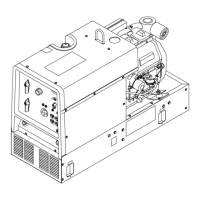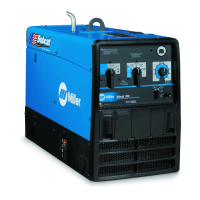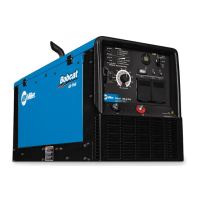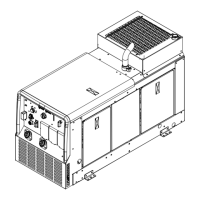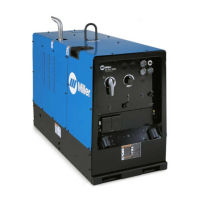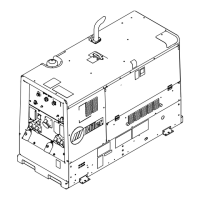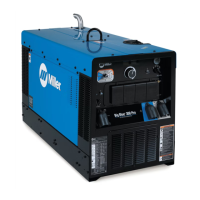OM-291417 Page 5
l Follow the guidelines in the Applications Manual for the Revised
NIOSH Lifting Equation (Publication No. 94-110) when manually
lifting heavy parts or equipment.
OVERHEATING can damage motors.
l Turn off or unplug equipment before starting or
stopping engine.
l Do not let low voltage and frequency caused by
low engine speed damage electric motors.
l Use only equipment suitable for operation on 60 or 50/60 Hz
power.
FLYING SPARKS can injure.
l Wear a face shield to protect eyes and face.
l Shape tungsten electrode only on grinder with
proper guards in a safe location wearing proper
face, hand, and body protection.
l Sparks can cause fires—keep flammables away.
MOVING PARTS can injure.
l Keep away from moving parts.
l Keep away from pinch points such as drive rolls.
BATTERY CHARGING OUTPUT and
BATTERY EXPLOSION can injure.
Battery charging not present on all models.
l Always wear a face shield, rubber gloves, and pro-
tective clothing when working on a battery.
l Stop engine before disconnecting or connecting battery cables,
battery charging cables (if applicable), or servicing battery.
l Do not allow tools to cause sparks when working on a battery.
l Do not use welder to charge batteries or jump start vehicles unless
it has a battery charging feature designed for this purpose.
l Observe correct polarity (+ and -) on batteries.
l Disconnect negative (-) cable first and connect it last.
l Keep sparks, flames, cigarettes, and other ignition sources away
from batteries. Batteries produce explosive gases during normal
operation and when being charged.
l Follow battery manufacturer’s instructions when working on or
near a battery. See Battery Service Manual (listed in Safety Stand-
ards) for additional information.
l Have only qualified persons do battery charging work.
l If battery is being removed from a vehicle for charging, disconnect
negative (-) cable first and connect it last. To prevent an arc, make
sure all accessories are off.
l Charge lead-acid batteries only. Do not use battery charger to sup-
ply power to an extra-low-voltage electrical system or to charge
dry cell batteries.
l Do not charge a frozen battery.
l Do not use damaged charging cables.
l Do not charge batteries in a closed area or where ventilation is
restricted.
l Do not charge a battery that has loose terminals or one showing
damage such as a cracked case or cover.
l Before charging battery, select correct charger voltage to match
battery voltage.
l Set battery charging controls to the Off position before connecting
to battery. Do not allow battery charging clips to touch each other.
l Keep charging cables away from vehicle hood, door, or moving
parts.
HIGH PRESSURE FLUIDS can injure
or kill.
l Engine fuel system components can be under high
pressure.
l Before working on fuel system, turn off engine to
release pressure.
l If any fluid is injected into the skin or body seek medical help
immediately.
WELDING WIRE can injure.
l Do not press gun trigger until instructed to do so.
l Do not point gun toward any part of the body, other
people, or any metal when threading welding wire.
OVERUSE can cause
OVERHEATING.
l Allow cooling period; follow rated duty cycle.
l Reduce current or reduce duty cycle before start-
ing to weld again.
l Do not block or filter airflow to unit.
STATIC (ESD) can damage PC
boards.
l Put on grounded wrist strap BEFORE handling
boards or parts.
l Use proper static-proof bags and boxes to store,
move, or ship PC boards.
TILTING OF TRAILER can injure.
l Use tongue jack or blocks to support weight.
l Properly install welding generator onto trailer ac-
cording to instructions supplied with trailer.
RECYCLE.
l Recycle or dispose of used liquids in an environ-
mentally safe way. This is especially true for en-
gine fluids such as drain oil and used coolant; this
is also important for coolant from torch/gun cooling
systems.
l Contact your local recycling office or your local distributor for infor-
mation about how to dispose of parts and equipment in an envi-
ronmentally safe way.
READ INSTRUCTIONS.
l Read and follow all labels and the Owner’s Manual
carefully before installing, operating, or servicing
unit. Read the safety information at the beginning
of the manual and in each section.
l Use only genuine replacement parts from the manufacturer.
l Perform installation, maintenance, and service according to the
Owner’s Manuals, industry standards, and national, state, and lo-
cal codes.
H.F. RADIATION can cause
interference.
l High-frequency (H.F.) can interfere with radio navi-
gation, safety services, computers, and communi-
cations equipment.
l Have only qualified persons familiar with electronic equipment per-
form this installation.
l The user is responsible for having a qualified electrician promptly
correct any interference problem resulting from the installation.
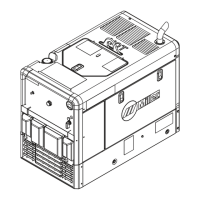
